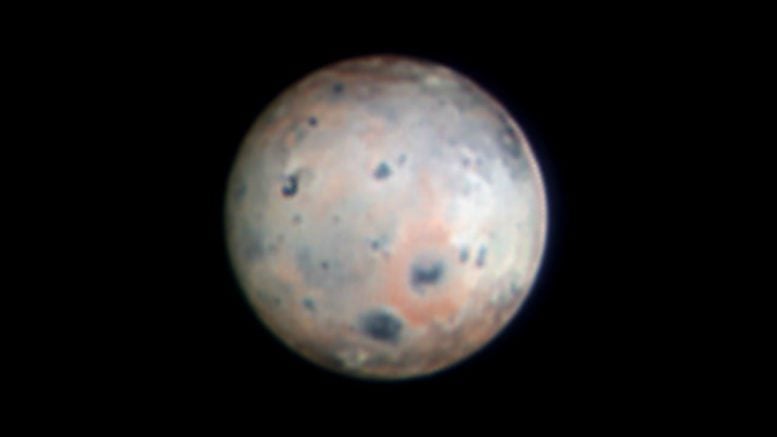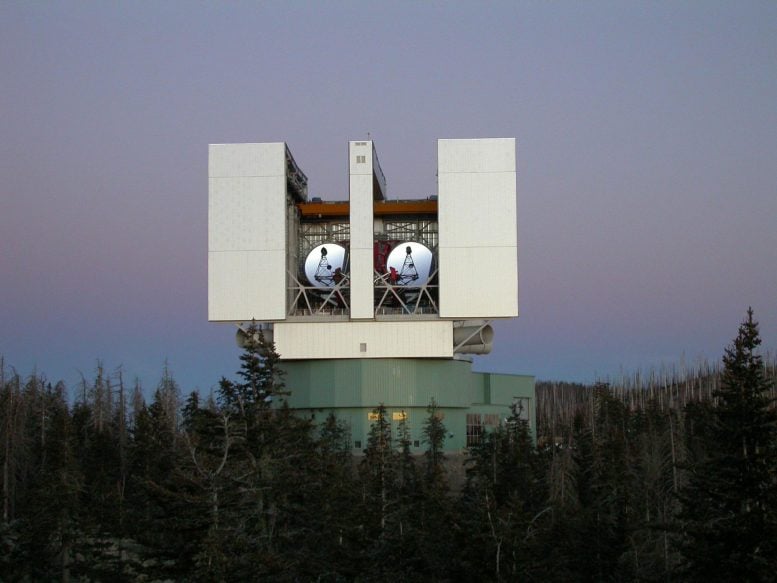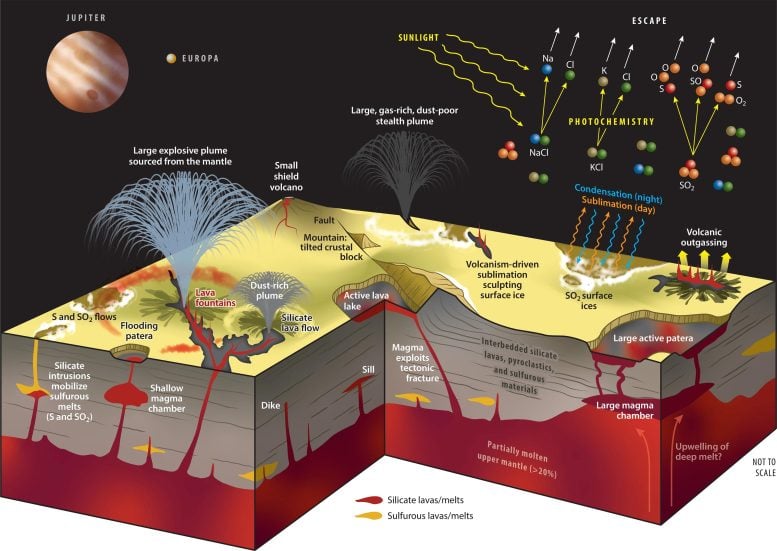
Jupiter’s moon Io, imaged by SHARK-VIS on January 10, 2024. This is the highest resolution image of Io ever obtained by a terrestrial telescope. The image combines three spectral bands – infrared, red and yellow – to highlight the reddish ring around the Pelé volcano (below and to the right of the center of the moon) and the white ring around Pillan Patera, to the right by Pele. Credit: INAF/Large Binocular Telescope Observatory/Georgia State University; IRV band observations by SHARK-VIS/F. Pedichine; treatment by D. Hope, S. Jefferies, G. Li Causi
Astronomers have captured a volcanic event on
” data-gt-translate-attributes=”({“attribute”:”data-cmtooltip”, “format”:”html”})” tabindex=”0″ role=”link”>Jupiterof the moon Io at a resolution never before achieved with Earth-based observations, thereby advancing our understanding of volcanic processes across the Solar System.
New images of Jupiter’s volcano-studded moon Io, taken by the Large Binocular Telescope at Mount Graham in Arizona, provide the highest resolution of Io ever achieved with a terrestrial instrument. The observations were made possible thanks to a new high-contrast optical imaging instrument, called SHARK-VIS, and the telescope’s adaptive optics system, which compensates for blur induced by atmospheric turbulence.
Unprecedented details revealed
The images, to appear in the magazine Geophysical research letters, reveal surface features as small as 50 miles in diameter, a spatial resolution that until now was only achievable with a spacecraft sent to Jupiter. According to the research team, this is equivalent to taking a photo of an object the size of a penny from a distance of 100 miles.
SHARK-VIS allowed researchers to identify a major resurfacing event around Pele, one of Io’s most significant volcanoes. According to the paper’s first author, Al Conrad, eruptions on Io, the most active volcanic body in the solar system, dwarf their contemporaries on Earth.

The Large Binocular Telescope Interferometer, or LBTI, is a ground-based instrument connecting two 8-meter-class telescopes on Mount Graham in Arizona to form the world’s largest single-mount telescope. The interferometer is designed to detect and study stars and planets outside our solar system. Credits: NASA/JPL-Caltech
Volcanic glimpses of Io
“Io therefore presents a unique opportunity to learn more about the powerful eruptions that helped shape the surfaces of the Earth and Moon in their distant past,” said Conrad, an associate scientist at the Large Binocular Telescope Observatory. . The Large Binocular Telescope, or LBT, is part of the Mount Graham International Observatory, a division of the University of Arizona’s Steward Observatory.
Conrad added that studies like this will help researchers understand why some worlds in the solar system are volcanic but not others. They could also one day shed light on the volcanic worlds of
” data-gt-translate-attributes=”({“attribute”:”data-cmtooltip”, “format”:”html”})” tabindex=”0″ role=”link”>exoplanet systems around nearby stars.
Gravitational dynamics and volcanism
Slightly larger than Earth’s moon, Io is the innermost of Jupiter’s Galilean moons, which include, in addition to Io, Europa, Ganymede and Callisto. Locked in a gravitational “tug of war” between Jupiter, Europa and Ganymede, Io is constantly compressed, leading to a build-up of frictional heat inside – which is believed to be the cause of its sustained and widespread volcanic activity.
By monitoring eruptions on Io’s surface, scientists hope to better understand the thermal movement of materials beneath the moon’s surface, its internal structure, and ultimately the tidal heating mechanism responsible for Io’s intense volcanism.

A cross-section of Io’s crust illustrating scientists’ current understanding of the geological and chemical processes that sculpt the surface and produce the moon’s atmosphere. On the left is a plume and red ring of sulfur similar to that generated by the Pelé lava lake. Faults in the mostly cold lithosphere serve as pathways for sulfur-rich silicate magma to reach the surface. Io’s interior is heated by friction caused by the gravitational tugs of Jupiter and two of its moons, Europa and Ganymede, which generate molten magma. Credit: de Pater et al., 2021, Annual Reviews, based on a figure by Doug Beckner, James Tuttle Keane, Ashley Davies
Historical context and recent discoveries
Io’s volcanic activity was first discovered in 1979, when Linda Morabito, an engineer on
” data-gt-translate-attributes=”({“attribute”:”data-cmtooltip”, “format”:”html”})” tabindex=”0″ role=”link”>NASA‘s Voyager mission spotted an eruption plume in one of the images taken by the spacecraft during its famous “Grand Tour” of the outer planets. Since then, countless observations have been made that document Io’s turbulent nature, both from space and ground-based telescopes.
Ashley Davies, study co-author and senior scientist at NASA’s Jet Propulsion Laboratory (
” data-gt-translate-attributes=”({“attribute”:”data-cmtooltip”, “format”:”html”})” tabindex=”0″ role=”link”>JPL), said the new image taken by SHARK-VIS is so rich in detail that it allowed the team to identify a major resurfacing event in which the plume was deposited around a major volcano known as Pele, located in the southern hemisphere of Io, near the equator. , is covered by eruption deposits from Pillan Patera, a neighboring volcano. A similar eruption sequence was observed by NASA’s Galileo space probe, which explored the Jupiter system between 1995 and 2003.
Technological advances in terrestrial observations
“We interpret the changes as dark lava deposits and white sulfur dioxide deposits from an eruption at Pillan Patera, which partially cover the red, sulfur-rich plume deposit at Pelé,” Davies said. “Before SHARK-VIS, such resurfacing events were impossible to observe from Earth.”
Although the telescope’s infrared images can detect hot spots caused by ongoing volcanic eruptions, they are not sharp enough to reveal surface details and unambiguously identify eruption locations, the co-explained. author Imke de Pater, professor emeritus of astronomy at the University of California – Berkeley.
“Sharper images at visible wavelengths like those provided by SHARK-VIS and LBT are essential for identifying both flare locations and surface changes not detectable in infrared, such as new plume deposits ” said de Pater, adding that visible light observations provide researchers with vital context for interpreting infrared observations, including those from spacecraft such as Juno, which currently orbits Jupiter.
Technological advances in observational astronomy
SHARK-VIS was built by the Italian National Institute of Astrophysics at the Rome Astronomical Observatory and is managed by a team led by principal investigator Fernando Pedichini, assisted by project manager Roberto Piazzesi. In 2023, it was installed, with its complementary near-infrared instrument SHARK-NIR, at the LBT to take full advantage of the telescope’s exceptional adaptive optics system. The instrument houses a fast, very low-noise camera that allows it to observe the sky in “fast imaging” mode, capture slow-motion images that freeze optical distortions caused by atmospheric turbulence, and post-process the data at an unprecedented level. acuity.
Gianluca Li Causi, head of SHARK-VIS data processing at the Italian National Institute of Astrophysics, explained how it works: “We process our data on the computer to remove any traces of the electronic fingerprint of the sensor. We then select the best frames and combine them using highly efficient software called Kraken, developed by our colleagues Douglas Hope and Stuart Jefferies at Georgia State University. Kraken allows us to remove atmospheric effects, revealing Io in incredible clarity.
Future prospects for observing the solar system
SHARK-VIS instrument scientist Simone Antoniucci said he expects new observations to be made of objects throughout the solar system.
“The fine vision of SHARK-VIS is particularly suitable for observing the surfaces of many bodies in the solar system, not only the moons of giant planets but also asteroids,” he said. “We have already observed some, with the data currently being analyzed, and plan to observe more. »